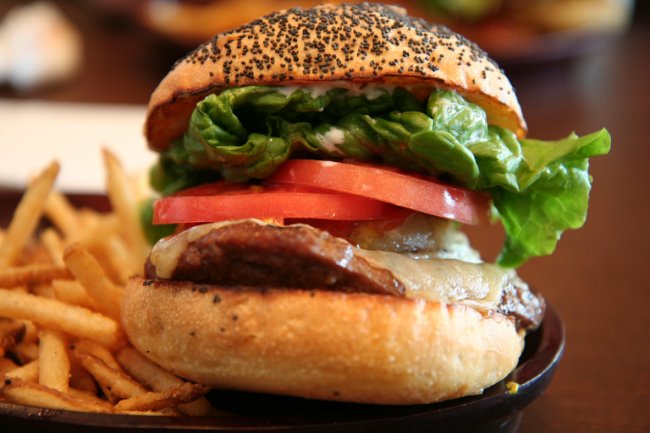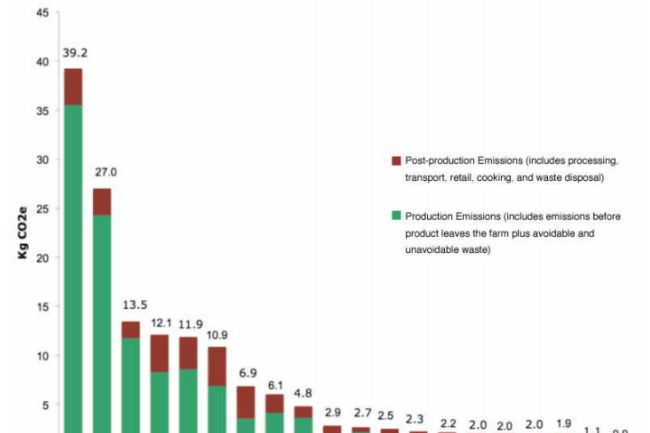 (Flickr)
(Flickr)
When you bite into a hamburger or slice into some salmon, do you think about the impact it had on the environment on its way to you?
Well, maybe you should. Climate change is getting real, and agriculture is one of the largest sources of heat-trapping greenhouse gases such as methane and carbon dioxide.
But when it comes to their “carbon footprint,” not all foods are created equal.
The Environmental Working Group, a Washington, D.C.-based research and advocacy organization, and CleanMetrics Corp., a Portland, Ore.-based environmental firm, put out a 2011 report called the “Meat Eater’s Guide to climate change + health.”
Here are the foods that produce the most greenhouse gas emissions per kilogram of food, based on that report.
(For comparison, the average car today emits about 0.41 kilograms of CO2 per mile driven.)
 (EWG and CleanMetrics)
(EWG and CleanMetrics)
We explain the reason behind each number below:
1. Lamb: 39.2 kg CO2
Sorry, lamb lovers — eating a kilo of lamb is equivalent to driving about 90 miles! A whopping 50% of lamb in the US is imported, according to the EWG/CleanMetrics report, so some of its carbon footprint comes from shipping. But most of it is produced by the animals’ digestion (aka lamb farts), their feed, manure management and other farm operations.
2. Beef: 27 kg CO2
Though not as bad as lamb, beef still has a pretty hefty carbon footprint. Cows produce a lot of methane (a potent greenhouse gas), and also require a lot of water and land, as this Business Insider analysis found.
3. Cheese: 13.5 kg CO2
And it’s not just meat. Cheese is also a major CO2 contributor. Only a small fraction of cheese is imported, but that accounts for half of all the carbon emissions from cheese, according to the report.
4. Pork: 12.1 kg CO2
Bacon and ham are next on the environmental chopping block. More than half of the emissions from pork come from raising the animals, but a good portion comes from processing, transport, and cooking the meat at home.
5. Farmed Salmon: 11.9 kg CO2
When it comes to farmed salmon, the biggest sources of greenhouse gas emissions are feed production, electricity generation and onfarm fuel combustion, according to the report. The report didn’t mention emissions from wild caught salmon, however.
This graphic from the report shows each food broken down by greenhouse gas emissions:
6. Turkey: 10.9 kg CO2
Thanksgiving may not be the greenest holiday, though it’s probably better than a Christmas roast. Most of the greenhouse gases from turkey come from feed production (especially corn), followed by processing and home cooking.
7. Chicken: 6.9 kg CO2
If you like eating meat but want to minimize your carbon footprint, chicken’s the way to go. It produces the least greenhouse gas emissions of most popular types of meat. While main sources of CO2 are the same as for turkey, chicken produces less overall emissions during each phase of production, processing, and cooking.
8. Canned Tuna: 6.1 kg CO2
The production of tuna (caught in the ocean and canned) produces most of its greenhouse gas emissions (68%) during diesel combustion on fishing boats. The rest mainly comes from processing and packaging the fish, as well as transporting it.
9. Eggs: 4.8 kg CO2
Eggs are probably your best choice of protein, if you’re trying to minimize your carbon footprint. The figure above is based on the average of a Canadian large-scale freerange farming operation and a New Jersey large-scale confined operation. Most of the emissions come from feed production, on-farm energy use, nitrous oxide gas from the poultry litter and fuel combustion.
10. Potatoes: 2.9 kg CO2
Potatoes produce the most emissions of all protein-rich plants. Most of the footprint comes from cooking, but it varies depending on how they’re cooked and for how long. For example, a baked potato produces many more emissions than French fries, because French fries taken much less time to cook.
Of course, there are many other factors at play in deciding which foods you should eat, such as nutrition, ethical farming/production practices, and, of course, personal preference.
NOW WATCH: Most expiration dates are bogus — here’s how long your food actually lasts
More From Business Insider
- By adding this substance to our food, we could prevent some of the worst foodborne disease outbreaks
- Here’s how common fruits and vegetables looked before and after people bred them
- Giant fans that suck carbon dioxide straight out of the air could help us fight global warming



























